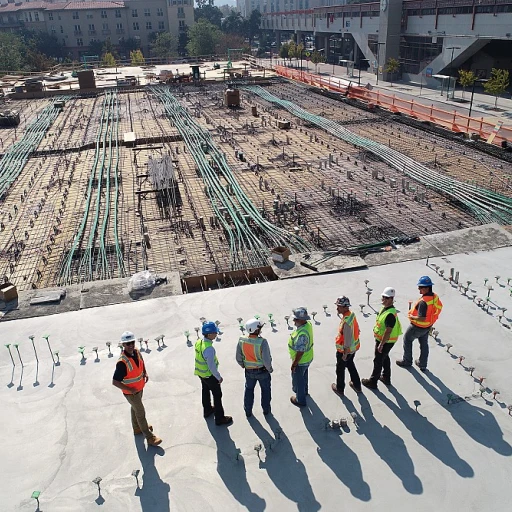
Understanding the Technical Workplace Environment
Recognizing the Dynamics of a Technical Environment
The technical workplace is a unique ecosystem characterized by its reliance on advanced technologies and a highly skilled workforce. In the United States and beyond, companies in this sector are driven by rapid innovation and the need for continuous adaptation. Understanding this environment is crucial for fostering effective employee engagement.
Technical employees often work in a digital workplace where cutting-edge technologies, such as artificial intelligence and data management systems, are integral to daily operations. This digital landscape not only shapes the way people work but also influences how they communicate and collaborate. The use of workplace technologies enables real-time communication and facilitates seamless integration among team members, which is vital for maintaining productivity and morale.
Emphasizing the Importance of Technical Skills
In a technical setting, the emphasis is on technical skills and expertise. Employees are expected to possess a high level of proficiency in their respective fields, whether it's software development, data analysis, or technical communication. This focus on skills is essential for the company's success but can also present challenges in terms of engagement. Technical workers often prioritize their job responsibilities over social interactions, which can lead to a sense of isolation.
Moreover, the technical workforce is diverse, encompassing a wide range of roles and responsibilities. This diversity requires a nuanced approach to engagement, taking into account the specific needs and preferences of different team members. Effective management must recognize these dynamics and implement strategies that resonate with the technical employees.
Adapting to the Digital Transformation
The digital transformation has reshaped the technical workplace, introducing new tools and platforms that enhance productivity and collaboration. However, it also poses challenges, such as data privacy concerns and the need for continuous learning. Companies must ensure that their employees are equipped with the necessary resources and support to navigate these changes successfully.
To truly understand the technical workplace environment, it's essential to consider how digital technologies impact the employee experience. This understanding can help businesses tailor their engagement strategies to better meet the needs of their technical workforce. For more insights on enhancing team collaboration through employee engagement, you can read more here.
Challenges in Engaging Technical Employees
The Digital Communication Paradox
In the fast-paced technology workplace of today, one of the main challenges is navigating the paradox of digital communication. While digital technologies facilitate real-time communication, they can also lead to misunderstandings if not managed properly. Technical employees rely heavily on precise communication, and any breakdown can hamper work efficiency. Companies need to foster channels that encourage clear and concise exchanges, enhancing teamwork and reducing the risk of technical blunders.Addressing Data Privacy Concerns
Data privacy is a significant concern among technical employees. As digital workplace technologies evolve, employees may fear that their data is more vulnerable than ever. This concern can hinder engagement, as workers may be reluctant to fully embrace new systems. It's crucial for management to implement robust data privacy measures and regularly communicate these standards to reassure the workforce.Balancing Work-Life Expectations
For technical workers, the lines between home and the workplace can blur due to digital technologies. This constant connectivity can lead to burnout, negatively impacting employee experience and engagement. Companies must prioritize work-life balance by setting clear boundaries for digital communication and ensuring that employees have time to disconnect from work-related technologies.Skilled Technical Workforce Dynamics
The dynamics within a skilled technical workforce can also pose challenges. With a diverse set of skills, management must ensure that each team member feels valued and included in decision-making processes. Creating a collaborative environment helps employees feel invested in their work and boosts overall engagement. Fostering collaboration for enhanced employee engagement is essential in maintaining a motivated team. By understanding these specific challenges, companies can better strategize to keep their technical workforce engaged and productive.Strategies for Enhancing Engagement
Effective Approaches to Increase Engagement
In a technical workplace, nurturing employee engagement requires a tailored approach, given the distinctive characteristics of a tech-oriented environment. Here's how organizations can enhance the engagement of technical employees: Focus on Professional DevelopmentTechnical employees appreciate opportunities to enhance their skills. Offering workshops, training programs, and certifications related to emerging technologies not only enhances their technical skills but also demonstrates the company’s investment in their growth. This investment can significantly boost employee morale and loyalty. Promote Open Communication
Clear, open communication helps technical staff remain informed and connected. Implement digital platforms for real-time updates and create channels where team members can voice their opinions and suggestions. This not only fosters a transparent culture but also encourages collaboration among employees. Utilize Workplace Technologies
Digital tools can transform the employee experience by streamlining workflows and facilitating effective collaboration. Utilizing advanced management systems, artificial intelligence, and collaboration software can enhance productivity, enabling employees to focus on complex problem-solving tasks rather than getting bogged down by routine processes. Discover more about essential tools for HR professionals to maximize engagement. Flexibility and Work-life Balance
Technical workers benefit from flexible working options, enhancing work-life balance and leading to greater job satisfaction. Offering options such as remote work or flexible hours respects their needs while accommodating diverse personal commitments, thereby boosting overall engagement. Through these strategies, companies can build a robust framework for engaging their technical workforce effectively and ensuring sustained productivity and motivation.
The Role of Leadership in a Technical Setting
Effective Leadership Fostering Engagement
Engaging employees in a technical workplace demands a unique approach, and leadership plays a pivotal role in this dynamic. With the blend of responsibility and opportunity, leaders are positioned to facilitate a vibrant and motivated atmosphere that positively impacts the entire company. Technical teams, armed with specific skills and rooted in digital technologies, require leaders who not only understand their business but also the intricacies of the technical work environment. Here’s how leadership can enhance engagement:- Open Communication Channels: It’s vital that leaders maintain clear and efficient communication with their team members. Given the complexity of technical roles, fostering open lines of communication ensures that team members feel heard and valued. This can be achieved via regular meetings, digital platforms, and real-time feedback systems.
- Empowerment through Skill Development: Empowering employees through training and development opportunities helps them stay relevant with evolving technologies. Implementing programs that boost technical skills not only motivates employees but also enhances their job performance and the overall technical workforce of the company.
- Recognize and Encourage Innovation: Leaders should encourage creative solutions and innovative approaches to technical challenges. Celebrating such achievements can create a culture of innovation and enhance job satisfaction.
- Data-Driven Decision Making: Utilizing management systems to make informed decisions can improve trust between leadership and technical employees. By relying on data to guide decisions, leaders can transparently communicate their choices, aligning with the technical environment’s demand for precision.
- Supportive Work Environment: Creating a supportive workplace where individuals feel their work-life balance is respected is crucial. Leaders should advocate for flexible working arrangements and consider the implications of digital workplace technologies on daily tasks.
Leveraging Technology for Engagement
Utilizing Workplace Technologies to Foster Engagement
The dynamic landscape of the technical workplace is evolving rapidly due to the integration of various digital technologies. These innovations have changed the way employees work and communicate, enhancing the overall employee experience. When implemented effectively, workplace technology can significantly boost engagement levels among technical workers.
In many technical settings, digital technologies play a crucial role in supporting everyday tasks. These tools not only streamline processes but also contribute to a more connected and efficient work environment, making it easier for team members to collaborate and share knowledge in real time. For example, project management systems enable team members to track progress and manage their responsibilities more effectively.
Moreover, advances in data privacy and encryption help companies ensure that the integration of these technologies is secure and trustworthy, maintaining employees' trust as they engage digitally. Employers are recognizing the importance of data security as a fundamental element of their engagement strategies.
By leveraging the right technologies, managers can facilitate technical communication and improve information flow, thus fostering a more engaged and productive workforce. These digital tools are particularly advantageous in environments where technical skills are key. They not only help optimize work processes but can also be used to tailor employee experience by providing opportunities for learning and development.
In conclusion, tech-savvy management harnesses the power of workplace technologies to cultivate a culture of engagement. By understanding and applying digital solutions, organizations can create an atmosphere where all employees feel valued and productive, leading to business success and a thriving company culture.
Measuring Engagement Success in Technical Roles
Evaluating Engagement in a Technical Workforce
Measuring engagement success in a technical workplace involves more than just surveying employees' feelings. It's about understanding both qualitative and quantitative data to paint a clearer picture of how employees interact with their work environment and the company's goals. To effectively gauge engagement levels, organizations often turn to a variety of workplace technologies. These tools can provide real-time data on employee experience, as well as insights into how workplace technology impacts productivity and morale.- Use of Digital Tools: In a technical setting, leveraging digital technologies such as artificial intelligence and advanced management systems can help track communication patterns among team members. Such insights are crucial for understanding how engaged employees are in their roles.
- Feedback Mechanisms: Regular feedback loops, supported by digital technology, allow technical workers to express their concerns and improvement suggestions. This continuous feedback not only helps in gauging current engagement levels but also assists management in addressing challenges head-on.
- Skill Development Tracking: By employing technologies that monitor skill acquisition and technical communication effectiveness, companies can assess whether employees are utilizing their skills and if any additional training might be necessary.
- Employee Experience Analysis: Companies in the United States and beyond use comprehensive analysis methods to understand how work life and workplace environments influence technical employees' overall engagement. The collected data aids in comparing engagement success across different business units within the organization.








